Oldsmobile Achieva 1995 s Owners Manual
Manufacturer: OLDSMOBILE, Model Year: 1995, Model line: Achieva, Model: Oldsmobile Achieva 1995Pages: 340, PDF Size: 16.99 MB
Page 91 of 340
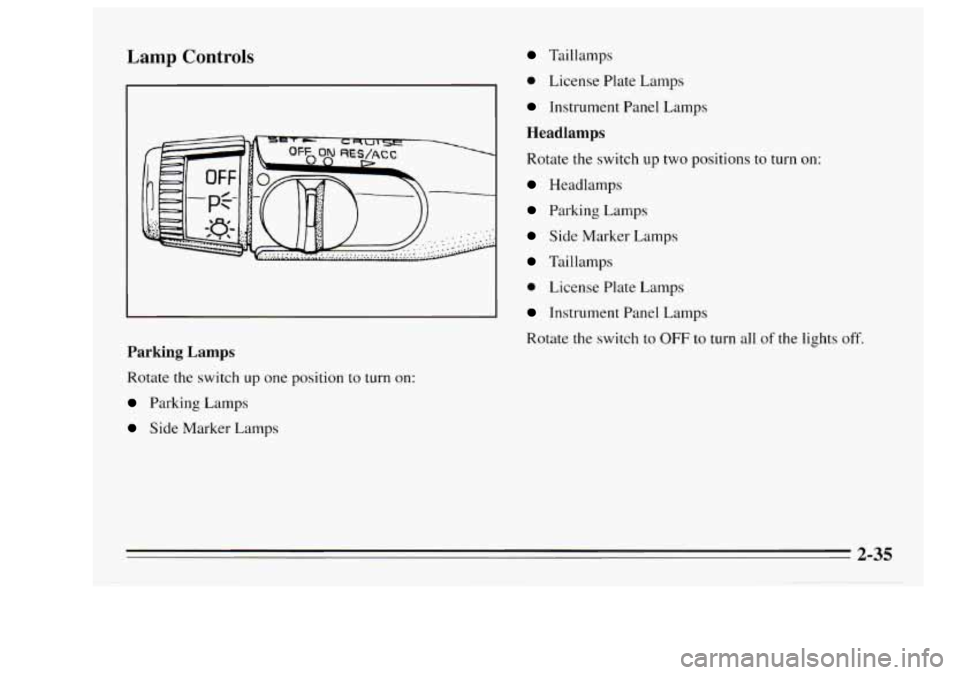
Lamp Controls
Parking Lamps
Rotate the switch up one position to turn on:
Parking Lamps
Side Marker Lamps
Tai 1 I amps
0 License Plate Lamps
Instrument Panel Lamps
Headlamps
Rotate the switch up two positions to turn on:
Headlamps
Parking Lamps
Side Marker Lamps
Taillamps
0 License Plate Lamps
Instrument Panel Lamps
Rotate the switch to
OFF to turn all of the lights off.
2-35
Page 92 of 340
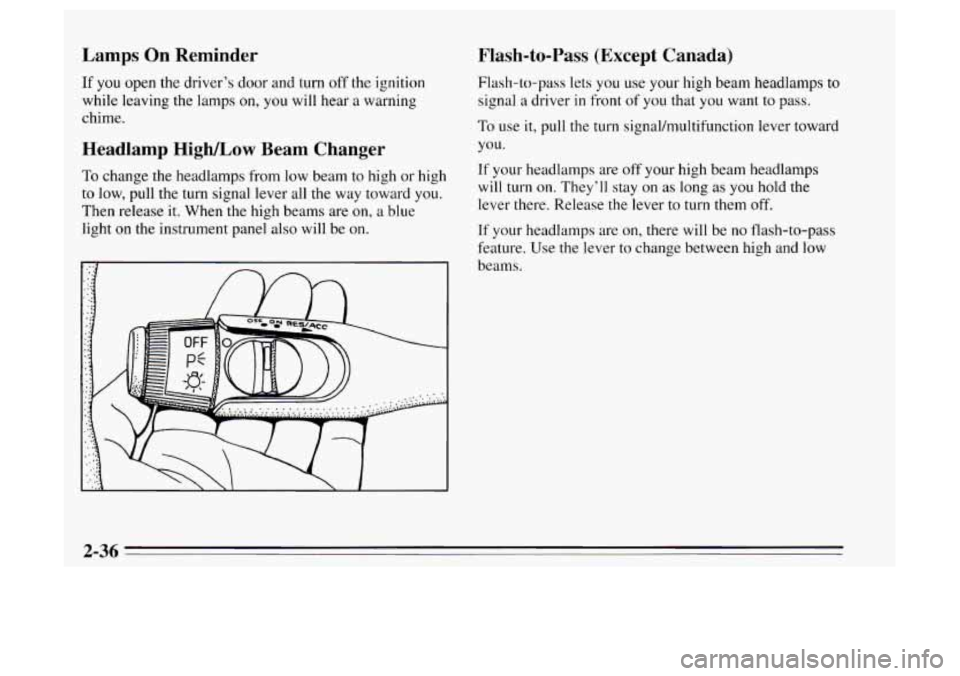
Lamps On Reminder
If you open the driver’s door and turn off the ignition
while leaving the lamps on,
you will hear a warning
chime.
Flash-to-Pass (Except Canada)
Flash-to-pass lets you use your high beam headlamps to
signal a driver
in front of you that you want to pass.
To use it, pull the turn signal/multifunction lever toward
Headlamp High/Low Beam Changer you.
To change the headlamps from low beam to high or high If your headlamps are off your high beam headlamps
will turn
on. They’ll stay on as long as you hold the to low, pull the turn signal lever all the way toward you.
Then release it. When the high beams are on, a blue
light
on the instrument panel also will be on. lever there. Release
thelever to turn them
off.
If your headlamps are on, there will be no flash-to-pass
feature. Use the lever
to change between high and low
beams.
2-36
Page 93 of 340
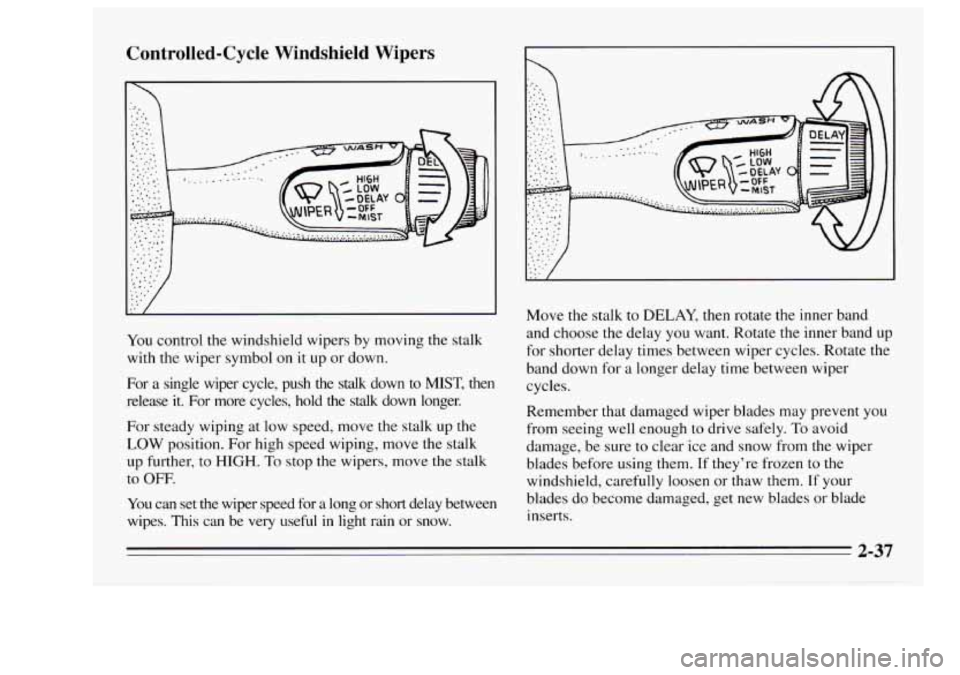
Controlled-Cycle Windshield Wipers
/
You control the windshield wipers by moving the stalk
with the wiper symbol on it up or down.
For a single wiper cycle, push
the stalk down to MIST, then
release
it. For more cycles, hold the stalk down longer.
For steady wiping at low speed, move the stalk up the
LOW position. For high speed wiping, move the stalk
up further, to
HIGH. To stop the wipers, move the stalk
to
OFF.
You can set the wiper speed for a long or short delay between
wipes. This can be very useful
in light rain or snow. Move
the stalk to
DELAY, then rotate the inner band
and choose the delay you want. Rotate the inner band up
for shorter delay times between wiper cycles. Rotate the
band down for a longer delay time between wiper
cycles.
Remember that damaged wiper blades may prevent you
from seeing well enough to drive safely.
To avoid
damage, be sure to clear ice and snow from the wiper
blades before using them. If they’re frozen to
the
windshield, carefully loosen or thaw them. If your
blades do become damaged, get new blades or blade
inserts.
2-37
Page 94 of 340
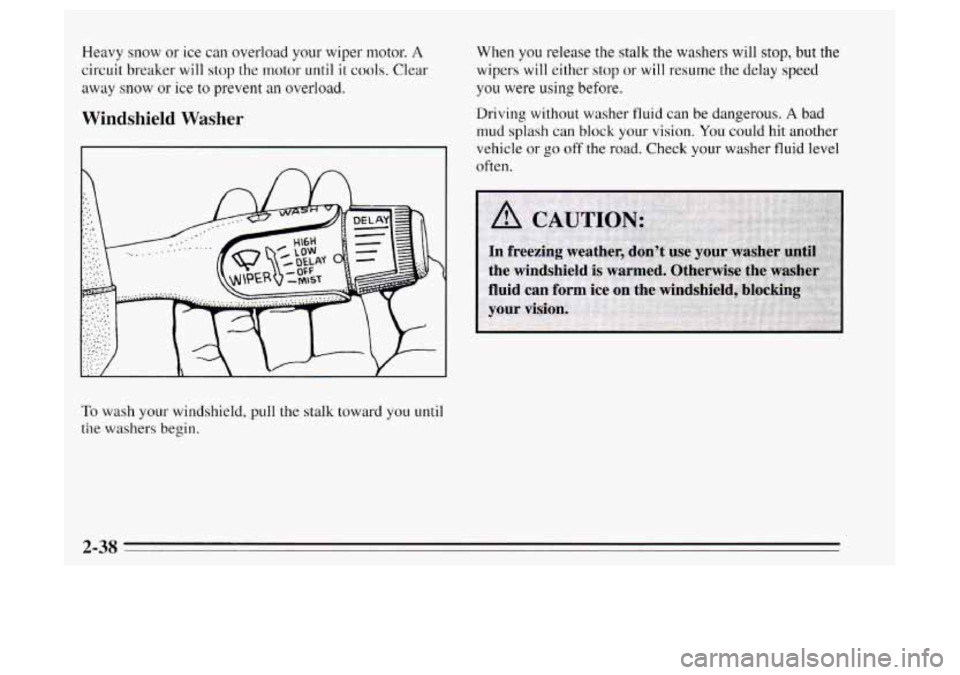
Heavy snow or ice can overload your wiper motor. A
circuit breaker will stop the motor until it cools. Clear
away snow or ice to prevent an overload.
Windshield Washer
To wash your windshield, pull the stalk toward you until
the washers begin. When you
release the stalk the washers will
stop, but the
wipers will either
stop or will resume the delay speed
you were using before.
Driving without washer fluid can be dangerous.
A bad
mud splash can block your vision.
You could hit another
vehicle or
go off the road. Check your washer fluid level
~ often.
Page 95 of 340
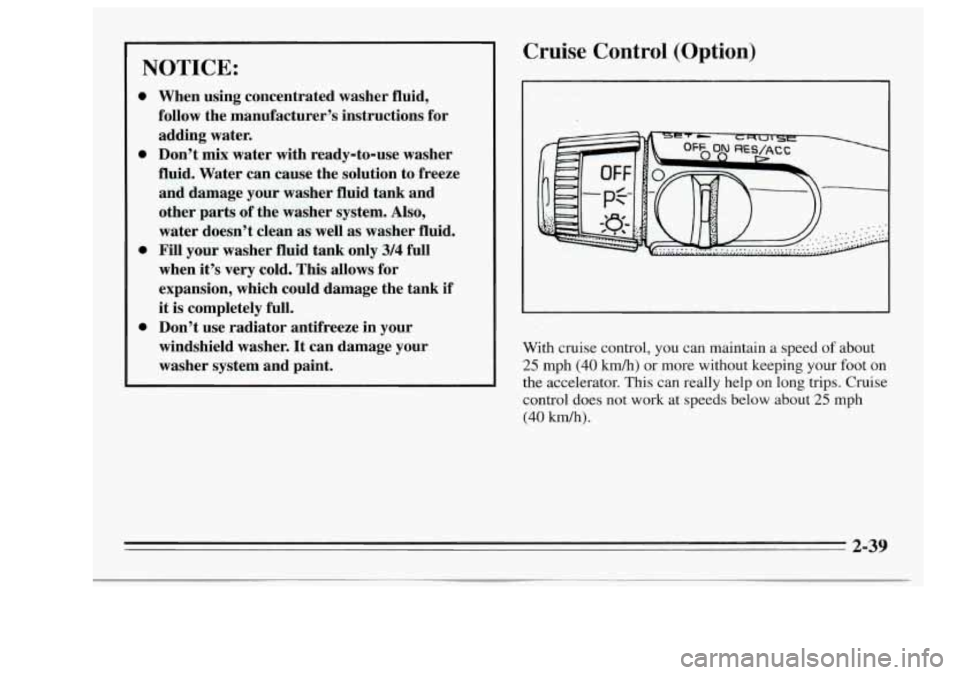
NOTICE:
0
0
0
0
When using concentrated washer fluid,
follow the manufacturer’s instructions for
adding water.
Don’t
mix water with ready-to-use washer
fluid. Water can cause the solution to freeze
and damage your washer fluid tank and
other parts of the washer system. Also,
water doesn’t clean
as well as washer fluid.
Fill your washer fluid tank only
314 full
when it’s very cold. This allows for
expansion, which could damage the tank
if
it is completely full.
Don’t use radiator antifreeze in your
windshield washer.
It can damage your
washer system and paint.
Cruise Control (Option)
With cruise control, you can maintain a speed of about
25 mph (40 km/h) or more without keeping your foot on
the accelerator. This can really help on long trips. Cruise
control does not work at speeds below about
25 mph
(40 km/h).
2-39
Page 96 of 340
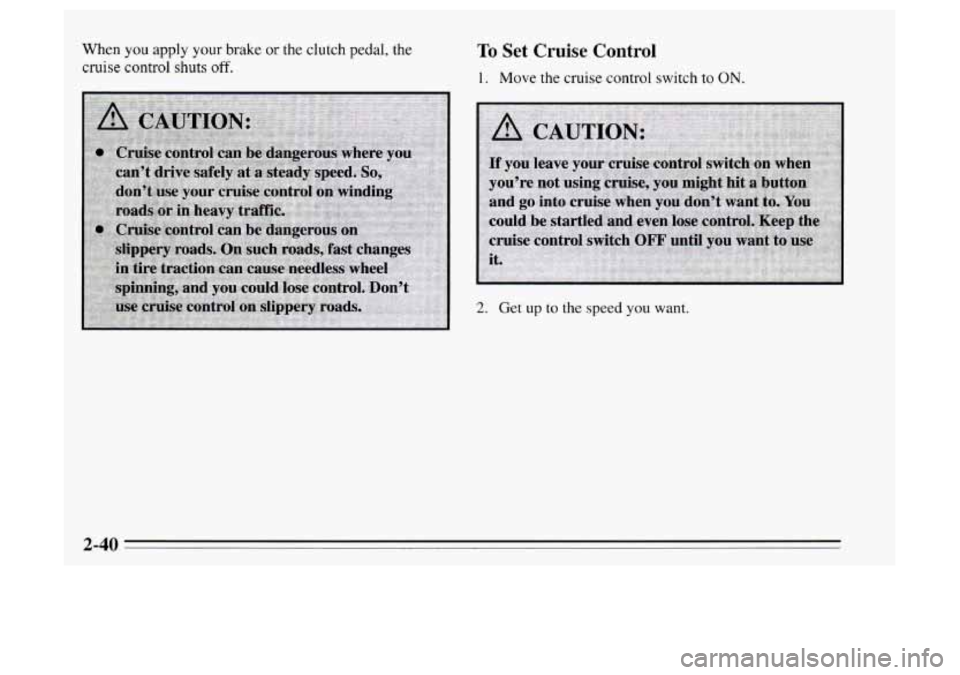
When you apply your brake or the clutch pedal, the
cruise control shuts off.
To Set Cruise Control
1. Move the cruise control switch to ON.
2-40
Page 97 of 340
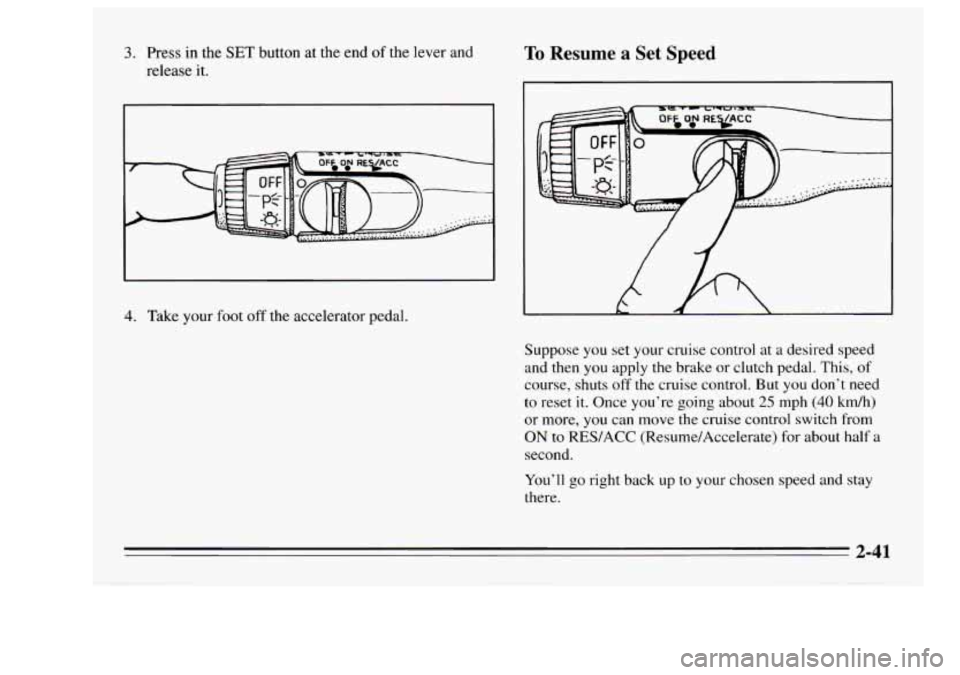
3. Press in the SET button at the end of the lever and
release it. To Resume a Set Speed
4. Take your foot off the accelerator pedal.
Suppose you set your cruise control at
a desired speed
and then
you apply the brake or clutch pedal. This, of
course, shuts off the cruise control. But you don’t need
to reset it. Once you’re going about
25 mph (40 kdh)
or more, you can move the cruise control switch from
ON to RES/ACC (Resume/Accelerate) for about half a
second.
You’ll go right back up
to your chosen speed and stay
there.
2-41
Page 98 of 340
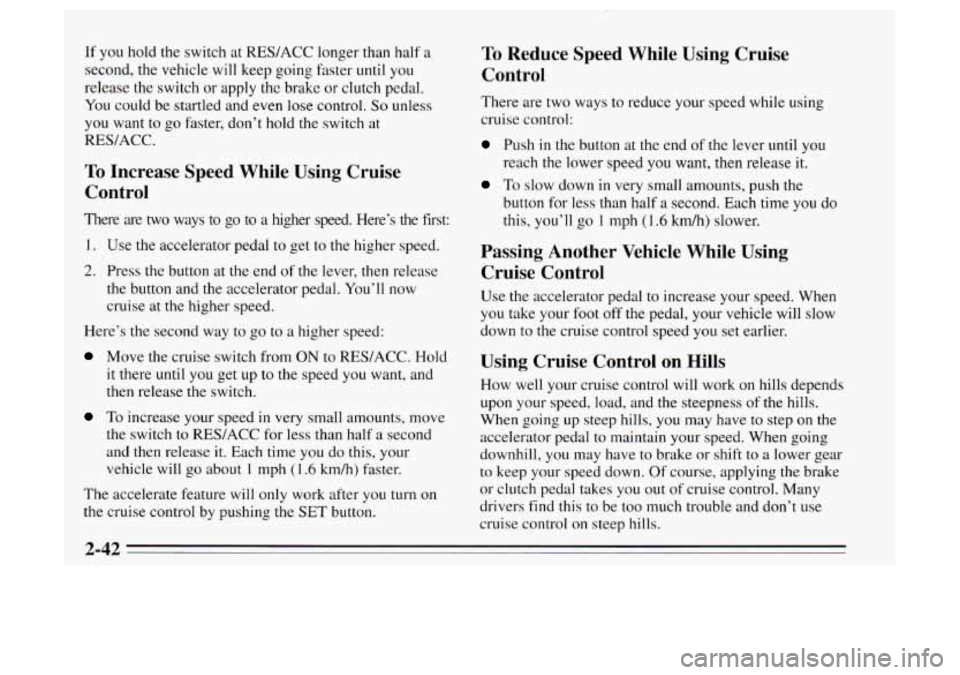
If you hold the switch at RES/ACC longer than half a
second, the vehicle will keep going faster until you
release the switch or apply the brake or clutch pedal.
You could be startled and even lose control.
So unless
you want to
go faster, don’t hold the switch at
REYACC.
To Increase Speed While Using Cruise
Control
There are two ways to go to a higher speed. Here’s the first:
1. Use the accelerator pedal to get to the higher speed.
2. Press the button at the end of the lever, then release
the button and the accelerator pedal. You’ll now
cruise at the higher speed.
Here’s the second way to go to
a higher speed:
Move the cruise switch from ON to RES/ACC. Hold
it there until you get up to the speed you want, and
then release the switch.
To increase your speed in very small amounts, move
the switch to
RES/ACC for less than half a second
and then release
it. Each time you do this, your
vehicle will go about 1 mph (1 -6 km/h) faster.
The accelerate feature will only work after you turn
on
the cruise control by pushing the SET button.
To Reduce Speed While Using Cruise
Control
There are two ways to reduce your speed while using
cruise control:
Push in the button at the end of the lever until you
reach the lower speed you want, then release it.
To slow down in very small amounts, push the
button for less than half
a second. Each time you do
this, you’ll
go 1 mph (1.6 kdh) slower.
Passing Another Vehicle While Using
Cruise Control
Use the accelerator pedal to increase your speed. When
you take your foot off
the pedal, your vehicle will slow
down to the cruise control speed you set earlier.
Using Cruise Control on Hills
How well your cruise control will work on hills depends
upon your speed, load, and the steepness of the hills.
When
going up steep hills, you may have to step on the
accelerator pedal to maintain your speed. When going
downhill, you may have to brake or shift to
a lower gear
to keep your speed down. Of course, applying the brake
or clutch pedal takes you out of cruise control. Many
drivers find this to be too much trouble and don’t use
cruise control
on steep hills.
2-42
Page 99 of 340

To Get Out of Cruise Control
There are two ways to turn off the cruise control:
Step lightly on the brake pedal or push the clutch
pedal, if you have
a manual transaxle; OR
Move the cruise switch to OFF.
To Erase Cruise Speed Memory
When you turn off the cruise control or the ignition,
your cruise control set speed memory is erased.
Instrument Panel Intensity Control
I A lNTER’OR 7
A LIGHTS
You can brighten or dim the instrument cluster lights by
rotating the wheel. Rotate the wheel all the way down to
turn
off the instrument cluster lights and displays.
Rotate
the wheel all the way up to turn on the courtesy
lamps.
2-43
Page 100 of 340
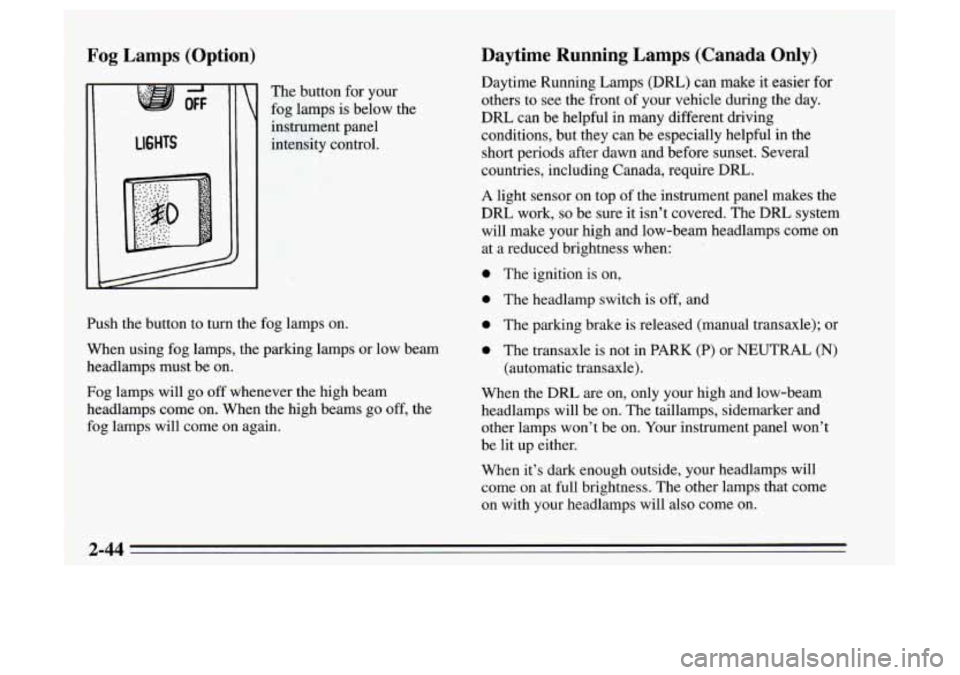
Fog Lamps (Option) Daytime Running Lamps (Canada Only)
7 %.
OFF
LIGHTS
The
button for your
fog lamps is below the
instrument panel
intensity control. Daytime Running
Lamps (DRL) can make it easier for
others to see the front of your vehicle during the day.
DRL can be helpful in many different driving
conditions, but they can
be especially helpful in the
short periods after dawn and before sunset. Several
countries, including Canada, require DRL.
A light sensor on top of the instrument panel makes the
DRL work,
so be sure it isn’t covered. The DRL system
will make your high and low-beam headlamps come on
at a reduced brightness when:
0 The ignition is on,
Push the button to turn the fog lamps on.
When using fog lamps, the parking lamps or low beam
headlamps must be on.
Fog lamps will go off whenever the high beam
headlamps come on. When the high beams go
off, the
fog lamps will come on again.
0 The headlamp switch is off, and
0 The parking brake is released (manual transaxle); or
0 The transaxle is not in PARK (P) or NEUTRAL (N)
(automatic transaxle).
When the DRL are on, only your high and low-beam
headlamps will be on. The taillamps, sidemarker and
other lamps won’t be on. Your instrument panel won’t
be lit up either.
When it’s dark enough outside, your headlamps will
come on at
full brightness. The other lamps that come
on with your headlamps will also come on.